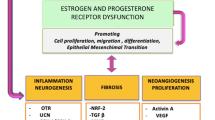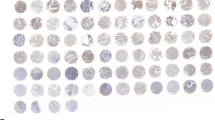Abstract
Apoptosis-stimulating p53 protein 2 (ASPP2) is an apoptosis inducer that acts via binding with p53 and epithelial polarity molecule PAR3. Lipolysis-stimulated lipoprotein receptor (LSR) is an important molecule at tricellular contacts, and loss of LSR promotes cell migration and invasion via Yes-associated protein (YAP) in human endometrial cancer cells. In the present study, to find how ASPP2 suppression promotes malignancy in human endometrial cancer, we investigated its mechanisms including the relationship with LSR. In endometriosis and endometrial cancers (G1 and G2), ASPP2 was observed as well as PAR3 and LSR in the subapical region. ASPP2 decreased in G3 endometrial cancer compared to G1. In human endometrial cancer cell line Sawano, ASPP2 was colocalized with LSR and tricellulin at tricellular contacts and binding to PAR3, LSR, and tricellulin in the confluent state. ASPP2 suppression promoted cell migration and invasion, decreased LSR expression, and induced expression of phosphorylated YAP, claudin-1, -4, and -7 as effectively as the loss of LSR. Knockdown of YAP prevented the upregulation of pYAP, cell migration and invasion induced by the ASPP2 suppression. Treatment with a specific antibody against ASPP2 downregulated ASPP2 and LSR, affected F-actin at tricellular contacts, upregulated expression of pYAP and claudin-1, and induced cell migration and invasion via YAP. In normal human endometrial epithelial cells, ASPP2 was in part colocalized with LSR at tricellular contacts and knockdown of ASPP2 or LSR induced expression of claudin-1 and claudin-4. ASPP2 suppression promoted cell invasion and migration via LSR and YAP in human endometrial cancer cells.








Similar content being viewed by others
References
Bergamaschi D, Samuels Y, Jin B, Duraisingham S, Crook T, Lu X (2004) ASPP1 and ASPP2: common activation of p53 family members. Mol Cell Biol 24:1341–1350
Cong W, Hirose T, Harita Y, Yamashita A, Mizuno K, Hirano H, Ohno S (2010) ASPP2 regulates epithelial cell polarity through the PAR complex. Curr Biol 20:1408–1414
Furuse M, Izumi Y, Oda Y, Higashi T, Iwamoto N (2014) Molecular organization of tricellular tight junctions. Tissue Barriers 2:e28960
Godin-Heymann N, Wang Y, Slee E, Lu X (2013) Phosphorylation of ASPP2 by RAS/MAPK pathway is critical for its full pro-apoptotic function. PLoS ONE 8:e82022
Ikenouchi J, Furuse M, Furuse K, Sasaki H, Tsukita S, Tsukita S (2005) Tricellulin constitutes a novel barrier at tricellular contacts of epithelial cells. J Cell Biol 171:939–945
Iosub-Amira A, Friedler A (2014) Protein–protein interactions of ASPP2: an emerging therapeutic target. Med Chem Commun 5:1435–1443
Kim DH, Lu Q, Chen YH (2019) Claudin-7 modulates cell-matrix adhesion that controls cell migration, invasion and attachment of human HCC827 lung cancer cells. Oncol Lett 17:2890–2896
Konno T, Kohno T, Kikuchi S, Shimada H, Satohisa S, Takano K, Saito T, Kondoh M, Kojima T (2020) Epithelial barrier dysfunction and cell migration induction via JNK/cofilin/actin by angulin-1/LSR ligand angubindin-1. Tissue Barriers 8:1695475
Li H, Wang X, Zhang C, Cheng Y, Yu M, Zhao K, Ge W, Cai A, Zhang Y, Han F, Hu Y (2018) HDAC1-induced epigenetic silencing of ASPP2 promotes cell motility, tumour growth and drug resistance in renal cell carcinoma. Cancer Lett 432:121–131
Liu ZJ, Lu X, Zhang Y, Zhong S, Gu SZ, Zhang XB, Yang X, Xin HM (2005) Downregulated mRNA expression of ASPP and the hypermethylation of the 5'-untranslated region in cancer cell lines retaining wild-type p53. FEBS Lett 579:1587–1590
Liu WK, Jiang XY, Ren JK, Zhang ZX (2010) Expression pattern of the ASPP family members in endometrial endometrioid adenocarcinoma. Onkologie 33:500–503
Masuda S, Oda Y, Sasaki H, Ikenouchi J, Higashi T, Akashi M, Nishi E, Furuse M (2011) LSR defines cell corners for tricellular tight junction formation in epithelial cells. J Cell Sci 124:548–555
Moleirinho S, Guerrant W, Kissil JL (2014) The Angiomotins–from discovery to function. FEBS Lett 588:2693–2703
Oda Y, Otani T, Ikenouchi J, Furuse M (2014) Tricellulin regulates junctional tension of epithelial cells at tricellular contacts through Cdc42. J Cell Sci 127:4201–4212
Papatheodorou P, Carette JE, Bell GW, Schwan C, Guttenberg G, Brummelkamp TR, Aktories K (2011) Lipolysis-stimulated lipoprotein receptor (LSR) is the host receptor for the binary toxin Clostridium difficile transferase (CDT). Proc Natl Acad Sci USA 108:16422–16427
Reaves DK, Fagan-Solis KD, Dunphy K, Oliver SD, Scott DW, Fleming JM (2014) The role of lipolysis stimulated lipoprotein receptor in breast cancer and directing breast cancer cell behavior. PLoS ONE 9:e91747
Ren J, Zhang J, Cai H, Li Y, Zhang Y, Zhang X, Zhao D, Li Z, Ma H, Wang J, Gao YE, Xiao L, Liu R, Qian J, Liu Y, Wei H, Li J (2014) HDAC as a therapeutic target for treatment of endometrial cancers. Curr Pharm Des 20:1847–1856
Romero-Pérez L, Garcia-Sanz P, Mota A, Leskelä S, Hergueta-Redondo M, Díaz-Martín J, López-García MA, Castilla MA, Martínez-Ramírez A, Soslow RA, Matias-Guiu X, Moreno-Bueno G, Palacios J (2015) A role for the transducer of the Hippo pathway, TAZ, in the development of aggressive types of endometrial cancer. Mod Pathol 28:1492–1503
Royer C, Koch S, Qin X, Zak J, Buti L, Dudziec E, Zhong S, Ratnayaka I, Srinivas S, Lu X (2014) ASPP2 links the apical lateral polarity complex to the regulation of YAP activity in epithelial cells. PLoS ONE 9:e111384
Shimada H, Satohisa S, Kohno T, Takahashi S, Hatakeyama T, Konno T, Tsujiwaki M, Saito T, Kojima T (2016) The roles of tricellular tight junction protein lipolysis-stimulated lipoprotein receptor in malignancy of human endometrial cancer cells. Oncotarget 7:27735–27752
Shimada H, Satohisa S, Kohno T, Konno T, Takano KI, Takahashi S, Hatakeyama T, Arimoto C, Saito T, Kojima T (2017a) Downregulation of lipolysis-stimulated lipoprotein receptor promotes cell invasion via claudin-1-mediated matrix metalloproteinases in human endometrial cancer. Oncol Lett 14:6776–6782
Shimada H, Abe S, Kohno T, Satohisa S, Konno T, Takahashi S, Hatakeyama T, Arimoto C, Kakuki T, Kaneko Y, Takano KI, Kojima ST (2017b) Loss of tricellular tight junction protein LSR promotes cell invasion and migration via upregulation of TEAD1/AREG in human endometrial cancer. Sci Rep 7:37049
Song B, Bian Q, Zhang YJ, Shao CH, Li G, Liu AA, Jing W, Liu R, Zhou YQ, Jin G, Hu XG (2015) Downregulation of ASPP2 in pancreatic cancer cells contributes to increased resistance to gemcitabine through autophagy activation. Mol Cancer 14:177
Sottocornola R, Royer C, Vives V, Tordella L, Zhong S, Wang Y, Ratnayaka I, Shipman M, Cheung A, Gaston-Massuet C, Ferretti P, Molnár Z, Lu X (2010) ASPP2 binds Par-3 and controls the polarity and proliferation of neural progenitors during CNS development. Dev Cell 19:126–137
Sullivan A, Lu X (2007) ASPP: a new family of oncogenes and tumour suppressor genes. Br J Cancer 96:196–200
Tian L, Deng Z, Xu L, Yang T, Yao W, Ji L, Lu Y, Zhang J, Wang LY (2018) Downregulation of ASPP2 promotes gallbladder cancer metastasis and macrophage recruitment via aPKC-ι/GLI1 pathway. Cell Death Dis 9:1115
Wang Y, Bu F, Royer C, Serres S, Larkin JR, Soto MS, Sibson NR, Salter V, Fritzsche F, Turnquist C, Koch S, Zak J, Zhong S, Wu G, Liang A, Olofsen PA, Moch H, Hancock DC, Downward J, Goldin RD, Zhao J, Tong X, Guo Y, Lu X (2014) ASPP2 controls epithelial plasticity and inhibits metastasis through β-catenin-dependent regulation of ZEB1. Nat Cell Biol 16:1092–1104
Wang F, Gao Y, Tang L, Ning K, Geng N, Zhang H, Li Y, Li Y, Liu F, Li F (2019a) A novel PAK4-CEBPB-CLDN4 axis involving in breast cancer cell migration and invasion. Biochem Biophys Res Commun 511:404–408
Wang J, Song T, Zhou S, Kong X (2019b) YAP promotes the malignancy of endometrial cancer cells via regulation of IL-6 and IL-11. Mol Med 25:32
Yu FX, Zhao B, Guan KL (2015) Hippo Pathway in Organ Size Control, Tissue Homeostasis, and Cancer. Cell 163:811–828
Zhao J, Wu G, Bu F, Lu B, Liang A, Cao L, Tong X, Lu X, Wu M, Guo Y (2010) Epigenetic silence of ankyrin-repeat-containing, SH3-domain-containing, and proline-rich-region- containing protein 1 (ASPP1) and ASPP2 genes promotes tumor growth in hepatitis B virus-positive hepatocellular carcinoma. Hepatolog 51:142–153
Zheng YF, Luo J, Gan GL, Li W (2019) Overexpression of microRNA-98 inhibits cell proliferation and promotes cell apoptosis via claudin-1 in human colorectal carcinoma. J Cell Biochem 120:6090–6105
Acknowledgements
This work was supported by the Ministry of Education, Culture, Sports, Science, and Technology, and the Ministry of Health, Labour and Welfare of Japan.
Author information
Authors and Affiliations
Corresponding author
Ethics declarations
Conflict of interest
The authors declare no competing financial interests.
Additional information
Publisher's Note
Springer Nature remains neutral with regard to jurisdictional claims in published maps and institutional affiliations.
Electronic supplementary material
Below is the link to the electronic supplementary material.
Rights and permissions
About this article
Cite this article
Konno, T., Kohno, T., Okada, T. et al. ASPP2 suppression promotes malignancy via LSR and YAP in human endometrial cancer. Histochem Cell Biol 154, 197–213 (2020). https://doi.org/10.1007/s00418-020-01876-8
Accepted:
Published:
Issue Date:
DOI: https://doi.org/10.1007/s00418-020-01876-8




